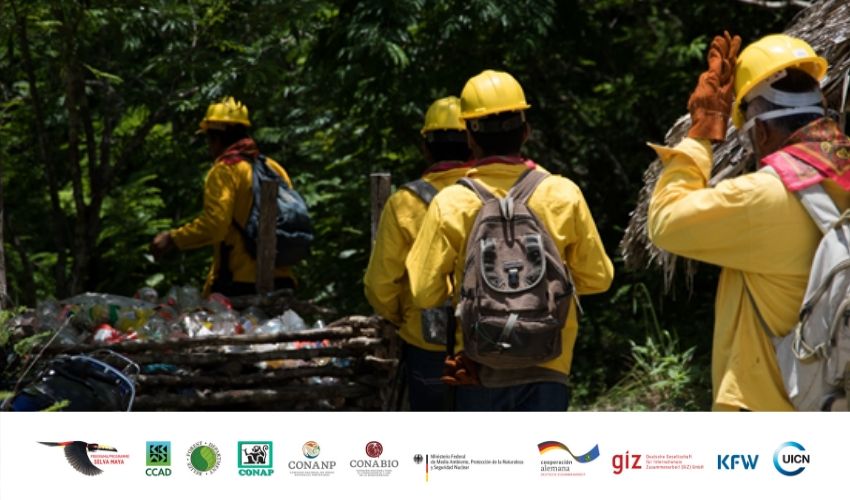Bala’an K’aax in the face of forest fires: “what is essential here is the commitment of the brigadistas”
Sensitive, committed, willing to innovate and create new ways of carrying out surveillance, restoration, monitoring and firefighting. This is how the director of the Bala’an K’aax Flora and Fauna Protected Area describes one of the community brigade members, one of the protected natural areas prioritized by the Selva Maya Natural Resources Protection project in Quintana Roo, Mexico.

UICN Brigadistas comunitarios ingresando a Área de Protección de Flora y Fauna Bala'an K'aax. Quintana Roo, México.
Photo: UICN / Eric Ecker
Mexico, June 29, 2020 (IUCN). In the midst of one of the most difficult years in terms of forest fires, due to the conditions of lower rainfall and increased temperatures caused by climate change, the community brigade members of Bala'an K'aax give themselves completely to save this valuable territory. Self-denial is the courage that drives the tasks of these brave men who are in charge of Sandra Flores, the director of this protected natural area, the only woman in this position in the Maya Forest.
Sandra Flores, directora del área protegida, expresa su orgullo por el equipo de brigadistas que trabajan junto a ella. Quintana Roo, México. 
The community brigades are made up of inhabitants of seven ejidos in the Bala’an K’aax area of influence (San Isidro Poniente, Venustiano Carranza, Sabana San Francisco, Puerto Arturo, Candelaria, San Felipe Primero and Othón P. Blanco). All carry out tasks as fire fighters, environmental monitoring with camera traps, community surveillance, ecosystem restoration, and some are beekeepers. All of them receive remuneration for their work, however, they also perform tasks on a voluntary basis, reflecting what the nature that surrounds them represents.
Jorge Luis Cervantes has been part of one of the brigades for five years, and says that one of the most shocking moments in the fight against forest fires is the encounter with animals that could not escape the fire; images that, he says, have strengthened his commitment to the conservation of the area.
 Jorge Luis Cervantes, brigadista comunitario, se mostró conmovido por el daño a la fauna que causan los incendios forestales. Quintana Roo, México.
Photo: UICN / Adriana González
Jorge Luis Cervantes, brigadista comunitario, se mostró conmovido por el daño a la fauna que causan los incendios forestales. Quintana Roo, México.
Photo: UICN / Adriana González
24% of the vertebrate population in Bala’an K’aax is subject to special protection, some species are threatened or endangered. Every year these species are threatened by forest fires which causes are anthropogenic, according to their director, “they are invasions, since they are found on presumably national lands, they burn because they intend to carry out agriculture or livestock. Upon detecting this, the complaint is made to the Federal Attorney for Environmental Protection and the Attorney General of the Republic.”
This year alone, the brigadistas have faced 4 fires that have affected 1,418.75 hectares in this protected natural area; while last year, they fought seven fires that affected 1,368.78 hectares.
Usually, the brigadistas detect smoke columns from watchtowers, and communicate it to the direction of the protected natural area to coordinate with the closest group and verify if it is a fire, its dimensions and thereby evaluate whether it can be attended by them or help is required. The health alert, which has been in place since March 27 due to the COVID-19 pandemic, has changed the dynamic, but has not stopped work. The brigadistas have remained in their community and instructions have been issued from the National Commission of Protected Natural Areas of Mexico (CONANP) such as the use of mouth masks, hand washing, mobilization to the office only if it is essential, and maintain communication by WhatsApp so that the fire care tasks continue.
“The brigade leaders have built important relationships that have allowed the work to proceed in a coordinated manner. On the other hand, I consider that for the attention of emergencies such as fires there are three important parts, knowledge as fire fighters, specialized equipment and supplies, but above all the willingness to work for the conservation and protection of protected areas. What is essential here is the commitment of the brigadistas”, recognizes the Director.
In the Yucatec Mayan language Bala'an means "hidden or hidden thing" and K'aax means "mount with trees, forest or grove"; In this way, Bala'an k'aax can be translated as "hidden forest". Brigadistas such as Emmanuel Cammal, head of the San Felipe Primero group, recognize the importance of strengthening and acquiring capacities to protect him.
Emmanuel Cammal, jefe de brigada, expresó su agradecimiento por el fortalecimiento de capacidades para combatir el fuego. Quintana Roo, México. 
In 2014, the Bala’am K’aax brigade members created the Muuch Canan K’aax community surveillance network, which in Mayan means “together we will take care of the jungle”; by then there were 4 brigades, but the following year all the others were integrated to strengthen each other and respond to emergencies immediately; There are currently 80 people in the network and a total of 9 brigades.
So far, the Government of Germany finances the Selva Maya program, and through the German Development Bank (KfW), supports IUCN and government counterparts in the implementation of the Selva Maya Natural Resources Protection project, which has benefited this Protected area with first aid and rescue courses in remote areas, basic course for fire fighters, personal protective equipment (pants, shirts, protective glasses, buff scarves, helmets, boots), specialized equipment such as blowers and chainsaws, GPS (global positioning systems, supplies, and fuel for equipment operation.
For more information contact: Adriana González, Communication Officer, adriana.gonzalez@iucn.org



